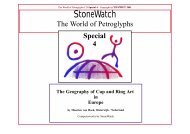petroglyphen im valle del encanto - StoneWatch
petroglyphen im valle del encanto - StoneWatch
petroglyphen im valle del encanto - StoneWatch
Sie wollen auch ein ePaper? Erhöhen Sie die Reichweite Ihrer Titel.
YUMPU macht aus Druck-PDFs automatisch weboptimierte ePaper, die Google liebt.
Fig. 4.2: Drawn copy of the „sacrifice<br />
scene“ showing one human with an axe<br />
in his raised hand, one anthropomorphic<br />
figure in motion (dance?), one unspecified<br />
„sacrificial an<strong>im</strong>al“, one dog, two<br />
snakes and four axes beside linings and<br />
cup-marks (Draft: P. Pohle)<br />
an<strong>im</strong>al style from the t<strong>im</strong>e of the<br />
Skythians. This specific artistic style<br />
from the middle of the first millennium<br />
B.C. is known also as the Eurasian<br />
an<strong>im</strong>al style for it occured all over<br />
Eurasia (see NOWGORODOWA,<br />
1980:172). Rock art of this particular<br />
style is wi<strong>del</strong>y spread over Central<br />
Asia (cf. JETTMAR, 1980, 1984;<br />
NOWGORODOWA, 1980). One of<br />
the oldest motifs in Kak Nyingba, at<br />
least typologically, besides „solar<br />
discs“, is the hoofprint (Fig. 6), which<br />
figures 238 t<strong>im</strong>es. This particular<br />
motif is also common in the rock art<br />
of Central Asia (e.g. Mongolia, Inner<br />
Mongolia, Siberia and Tibet), whereas<br />
no parallels exist in Indian rock<br />
paintings and engravings. In eastern<br />
Mongolia one rock art site (Arsaan<br />
Chad) with numerous petroglyphs of<br />
hoofprints has been described by<br />
Fig. 5.2: Drawn copy of the blue sheep looking back at a labyrinth<br />
(or trap?). The motif has been artistically engraved into rough<br />
sandstone (Draft: P. Pohle)<br />
NOWGORODOWA (1980:51). A very fortunate situation for<br />
the dating of these petroglyphs was the discovery of one rock<br />
30<br />
Fig. 5.1: Photograph of the blue sheep engraving with<br />
a labyrinth (or trap?) (P. Pohle)<br />
with hundreds of engraved pictures - including numerous<br />
hoofprints - whose lower part was covered by a cultural layer<br />
from a Neolithic workshop. Therefore, the petroglyphs must<br />
be older than the Neolithic settlement (a Mesolithic age was<br />
presumed). The hoofprints are very s<strong>im</strong>ilar to the petroglyphs<br />
of Kak Nyingba, not only in terms of their typology,<br />
engraving style and technique used, but also in size and the<br />
high number of engravings, as well as in their combination<br />
with other motifs (e.g. squares, semicircles).<br />
Origins<br />
The rock engravings themselves give no direct clues as to the<br />
ethnic origin of those who created them; however, several<br />
features suggest that the engravings were the products of permanent<br />
residents rather than of travellers passing by, such as:<br />
-<br />
-<br />
-<br />
-<br />
-<br />
-<br />
the sacred character of the petroglyph<br />
site,<br />
the engravings of hunting scenes<br />
with native wild an<strong>im</strong>als (e.g.<br />
blue sheep),<br />
the great effort in terms of t<strong>im</strong>e<br />
and experience which was necessary<br />
to engrave complex scenes<br />
into a sandstone whose very hard<br />
weathered rock surface was difficult<br />
to work with.<br />
Function of the place<br />
A great deal of evidence indicates<br />
that the rock art site was used for cult<br />
or ceremonial purposes. Some evidence<br />
is listed as follows:<br />
-<br />
-<br />
the placement of a large number<br />
of the same motifs together (e.g.<br />
hoofprints, footprints, solardiscs“,<br />
snakes), which is usually interpreted<br />
as an expression of cult or ritual<br />
activities in rock art research;<br />
the existence of a rock niche covered<br />
in soot, in which fire sacrifices<br />
were presumably made, located<br />
close to the engraving of the<br />
„sacrifice scene“ (Fig. 4.1 & 4.2);<br />
the engraving of the „sacrifice scene“ itself;<br />
the large number of cup-marks and bowls connected to<br />
each other by grooves which may have been used for<br />
liquid sacrifices, and<br />
the more recent engravings of Tibetan Buddhist symbols<br />
and inscriptions.<br />
The petroglyph site and the deserted settlement<br />
Although investigations into the relationship between the<br />
rock engravings and the nearby deserted settlement of Kak<br />
Nyingba have not been completed yet, we can assume that<br />
the petroglyph site was formerly used by the inhabitants of<br />
the village. A mortar hole testifies to this, as well as several<br />
rock engraved game boards of ramarildok, a Tibetan game
















